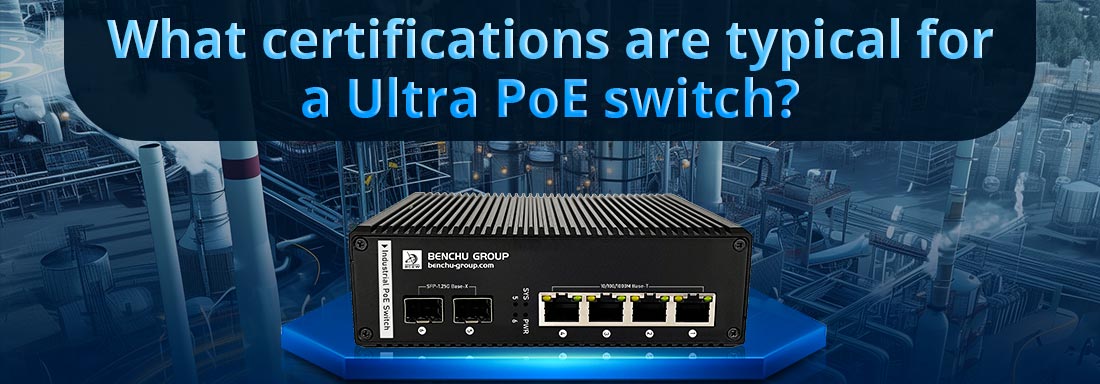
Os switches Ultra PoE (Power over Ethernet) geralmente possuem diversas certificações que garantem sua confiabilidade, desempenho, segurança e conformidade com os padrões do setor. Aqui está uma descrição detalhada das certificações típicas associadas aos switches Ultra PoE:
1. Conformidade com os padrões IEEE
IEEE 802.3af: Este padrão define as especificações para PoE, permitindo que dispositivos recebam energia e dados pelo mesmo cabo Ethernet. Ele especifica uma potência máxima de 15,4 watts por porta.
IEEE 802.3at (PoE+): Um aprimoramento do padrão PoE original, o PoE+ aumenta a potência máxima para 30 watts por porta. Esta certificação é importante para dispositivos que requerem mais energia, como câmeras pan-tilt-zoom (PTZ) e pontos de acesso sem fio.
IEEE 802.3bt (PoE++): O padrão mais recente permite um fornecimento de energia ainda maior, até 60 watts por porta (Tipo 3) e 100 watts (Tipo 4). A conformidade com este padrão é crucial para dispositivos que possuem altas demandas de energia.
2. Certificações de segurança
Certificação UL: A certificação Underwriters Laboratories (UL) indica que o switch foi testado quanto aos padrões de segurança na América do Norte. Ele garante que o switch atenda aos requisitos específicos de segurança elétrica, reduzindo o risco de choque elétrico, incêndio e outros problemas de segurança.
Marcação CE: A marca CE indica que o switch está em conformidade com os padrões europeus de saúde, segurança e proteção ambiental. Esta certificação é obrigatória para produtos vendidos no Espaço Económico Europeu (EEE).
Conformidade com a FCC: A certificação da Federal Communications Commission (FCC) é exigida nos Estados Unidos e indica que o switch atende aos padrões específicos de interferência eletromagnética (EMI), minimizando o risco de interrupção de outros dispositivos eletrônicos.
3. Certificações Ambientais
Conformidade com RoHS: A certificação de Restrição de Substâncias Perigosas (RoHS) garante que o switch esteja livre de certos materiais perigosos, como chumbo, mercúrio, cádmio e certos retardadores de chama. Esta certificação promove a sustentabilidade ambiental e a segurança.
Conformidade com REEE: A certificação de Resíduos de Equipamentos Elétricos e Eletrônicos (REEE) está relacionada ao descarte de lixo eletrônico. Ele garante que o fabricante forneça opções adequadas de reciclagem e descarte para o switch no final de seu ciclo de vida.
Classificações IP: Embora não seja uma certificação no sentido tradicional, as classificações de proteção de ingresso (IP), como IP40 ou IP65, indicam a resistência do switch à poeira e à água. Isto é particularmente importante para interruptores utilizados em ambientes externos ou industriais.
4. Certificações de Gestão da Qualidade
ISO 9001: Esta certificação significa que o fabricante segue princípios de gestão de qualidade, garantindo qualidade consistente do produto e melhoria contínua. A certificação ISO 9001 é importante para estabelecer confiança na confiabilidade e no desempenho do switch.
ISO 14001: Esta certificação centra-se nos sistemas de gestão ambiental e indica que o fabricante está empenhado em reduzir o seu impacto ambiental. Isto é particularmente relevante para organizações que procuram produtos sustentáveis e ecológicos.
5. Certificações de rede e desempenho
IEEE 802.1Q: Esta certificação refere-se à marcação de VLAN (Virtual Local Area Network) e é essencial para gerenciar o tráfego de rede. A conformidade com este padrão é importante para switches usados em ambientes de rede complexos.
IEEE 802.1P: Esta certificação refere-se à Qualidade de Serviço (QoS) para priorizar o tráfego de rede. A conformidade garante que o switch possa gerenciar com eficiência fluxos de dados e oferecer suporte a aplicativos que exigem desempenho confiável, como voz sobre IP (VoIP) e videoconferência.
6. Testes e Certificação para Aplicações Específicas
Conformidade NEBS (sistema de construção de equipamentos de rede): Para equipamentos de telecomunicações e de rede, a conformidade NEBS indica que o equipamento atende a padrões específicos de confiabilidade e requisitos ambientais, especialmente em ambientes de telecomunicações.
Conformidade MIL-STD: Para switches destinados a aplicações militares ou de defesa, a conformidade com os padrões militares (MIL-STD) garante robustez e confiabilidade sob condições adversas, incluindo temperaturas extremas e tensões ambientais.
Conclusão
Ultra Interruptores PoE normalmente possuem uma série de certificações que destacam sua adesão aos padrões de segurança, desempenho, ambientais e melhores práticas do setor. Certificações como conformidade IEEE para padrões PoE, certificações de segurança como UL e CE e certificações ambientais como RoHS e WEEE são essenciais para garantir que esses switches possam fornecer energia e dados de maneira confiável, ao mesmo tempo que atendem às expectativas regulatórias e dos clientes. Estas certificações não só aumentam a credibilidade do produto, mas também proporcionam garantia aos utilizadores relativamente à segurança, fiabilidade e responsabilidade ambiental dos equipamentos que escolhem para a sua infra-estrutura de rede.